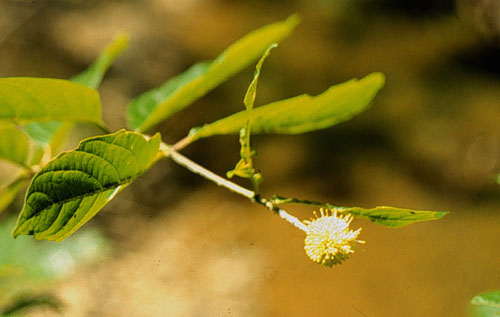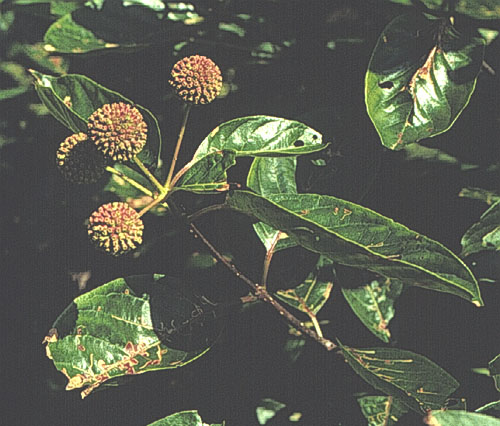Cephalanthus occidentalis
Buttonbush, Button-willow
Rubiaceae
ExpandHabitat
- hardy to zone 5
- native throughout the eastern half of North America. It is also found from Texas through parts of New Mexico, Arizona and California.
Habit and Form
- a deciduous shrub
- 3' to 6' tall in the northern part of its range, but to 10' to 12' tall in the southern part of its range
- shape is rounded and spreading
- loose and somewhat open
- multistemmed
Summer Foliage
- deciduous simple leaves
- very late to leaf out in the spring
- opposite or whorled leaf arrangement
- ovate leaves with acute bases and tips
- 2" to 6" long and 1" to 3" wide
- medium to dark green color
- glossy
Autumn Foliage
- usually greenish-yellow to yellow
Flowers
- in globular heads about 1" across
- creamy white, somewhat fragrant
- bloom time is June, July, August
- moderately ornamental, but not exceptional
Fruit
- small nutlets are held in 1" diameter globular balls
- before drying, color is green with red hilights
- the fruits persist into the winter
Bark
- coarse stems are somewhat 4-sides
- color varies from gray-brown to shiny olive
- prominent vertical lenticels are present on stems
- older stems become reddish-brown and the lenticels enlarge into fissures
Culture
- likes moisture
- full sun to light shade
- easily grown as long as the site is not dry
- requires periodic rejuventation pruning
- relatively pest free
Landscape Use
- naturalistic areas
- water's edge
- shrub border
Liabilities
- can be short-lived
- can become coarse, sprawling and ungainly
- needs periodic rejuvenation pruning to maintain form and vigor
ID Features
- prominent lenticels on stems
- stems coarse
- simple, glossy leaves
- creamy white flowers throughout the summer
- terminal buds absent
- lateral buds are sessile and found in depressions above each leaf scar
- leaf scars are more or less circular
- pith is solid and light brown
Propagation
- softwood or hardwood cuttings root easily
- by seed is also easy without pretreatment
Cultivars/Varieties
- none are commonly available




